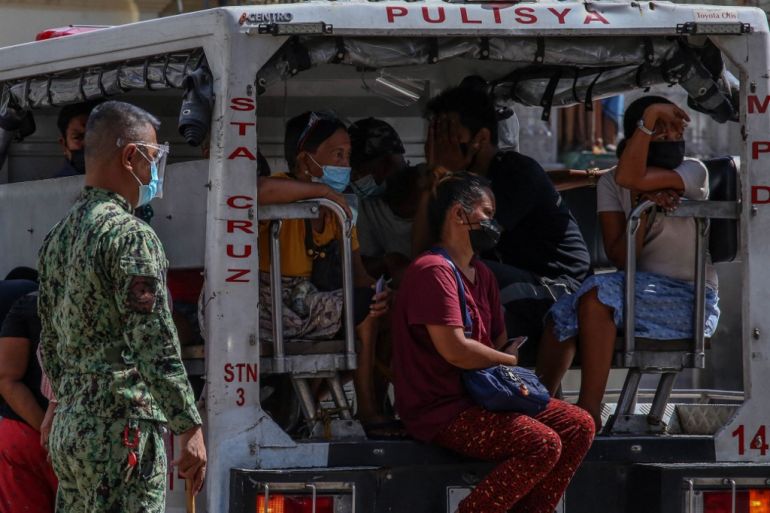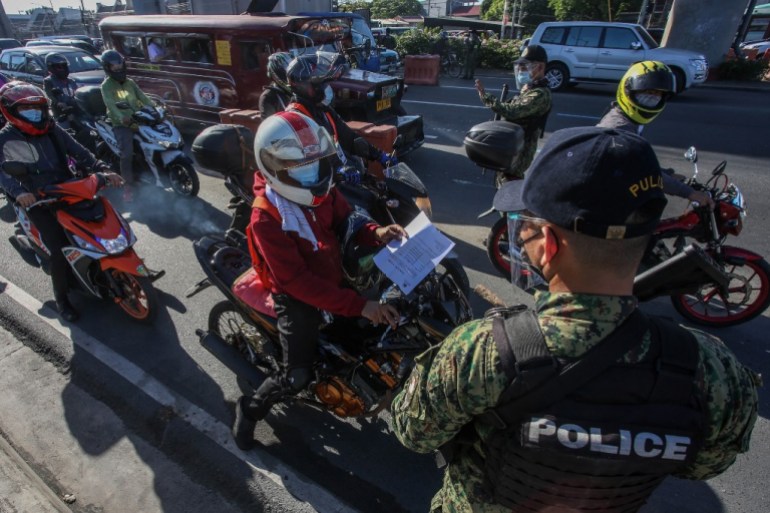Argument over porridge reveals Philippines’ COVID fiasco
Viral video of a confused altercation on lockdown rules exposes fundamental errors in the Duterte administration’s pandemic response.

Manila, Philippines – Is lugaw – a savoury Filipino rice porridge – essential?
Filipinos have both laughed and fumed at the question for over a week now after a village official outside of Metro Manila apprehended motorcycle riders for waiting outside a restaurant past curfew during the current lockdown.
Keep reading
list of 3 itemsPhilippines closes border to foreigners, some citizens over COVID
Philippines announces strict COVID lockdown in and around Manila
Since March 29, the Philippine capital and its neighbouring provinces have returned to stricter lockdown to curb an alarming new wave of COVID-19 infections that has hit new records.
One of the riders, Marvin Ignacio, was about to deliver porridge to customers, who booked his services through a mobile app, when he was stopped. He reasoned that the food item belonged to the “essential goods” allowed by the government for delivery beyond curfew hours.
The village official, however, proceeded to lecture Ignacio on what qualified as essential. Unlike water, milk, and grocery items, the porridge was not essential because a person could last a day without it, the official insisted.
The official then ordered the restaurant to close down immediately, and the food delivery service riders waiting outside to go home.
Luckily for Ignacio, he had the whole incident on Facebook live video, and it went viral in a matter of hours, igniting an outcry and setting off several memes on social media.
“Anyone will tell you, it’s food. Food is essential. Lugaw is food. Therefore, lugaw is essential, right? It’s common sense,” Ignacio told Al Jazeera later on.
The office of President Rodrigo Duterte was forced to issue a statement on the incident, with his spokesman Harry Roque saying that the delivery of food items must remain unhampered, and should not be held up at checkpoints.
“The local regulation must be consistent” with national lockdown regulations, interior department spokesman Jonathan Malaya told Al Jazeera.
Heavy policing during a pandemic
The incident punctuated an anxiety-inducing week of record COVID-19 tallies, the highest of which was on April 2 with 15,298 new infections.
As of Tuesday, the government reported 152,562 active cases in the country, pushing the total over 800,000. The number of deaths also hit a record daily high of 382, bringing the total to more than 13,800 fatalities.
This randomized dot map shows the comparison in the number of active COVID-19 cases in the National Capital Region between March 8, 2021 and March 29, 2021.
See original post here: https://t.co/K8U64V9YVF pic.twitter.com/68MMZYA6ph
— University of the Philippines (@upsystem) April 5, 2021
With the country already facing the sharpest economic decline since World War II and worsening unemployment, analysts say many Filipinos are growing more frustrated with the government’s failure to contain the virus after more than a year of repeated lockdowns.
“It really underscores the absurdity of the government’ lockdown policies. It pits the law enforcement perspective of the government against the basic necessities of people,” JC Punongbayan, an analyst from the University of the Philippines School of Economics, told Al Jazeera.
The government under Duterte has responded to the pandemic in much the same way as it did to other national problems: a law-and-order crackdown with heavy policing.
Duterte put former military and police generals in charge of key areas of his pandemic response, including contact tracing, vaccinations and social welfare, defying calls for him to enlist public health experts.
When the pandemic reached the Philippines in March 2020, Duterte enforced a lockdown on Manila and the surrounding provinces for nearly 5 months, one of the longest in the world.
BREAKING: DOH reports 15,310 new cases today, a new record-high ‼️
Active cases (now more than 150,000) have reached a new record-high for the 4th straight day ⚠️
3,709 case backlogs from COVIDKaya were included today.
Seven labs were not able to submit data. pic.twitter.com/EKwTUFHRVi
— Edson (@EdsonCGuido) April 2, 2021
Evolving tiers of lockdowns
Much of the policymaking revolved around which types of businesses were allowed to operate under different tiers of lockdowns, where people may or may not travel, what modes of public transport should be allowed in the streets and how many people should board them.
Filipinos, concerned more about daily survival than watching the news, could barely keep track of the evolving lockdown tiers and rules. Stretched thin, the police and military were hardly consistent with implementation.
Because of the confusion, many people ended up inadvertently breaking lockdown rules, with police or village officials rounding them up and gathering them in halls where social distancing could scarcely be practised.

False dilemma
A year since the first lockdown began, the Philippines still finds itself unprepared for a sudden, dramatic increase in COVID-19 infections.
Hospitals in the capital region and nearby provinces have become so overcrowded they have had to turn away patients needing intensive care.
Critics blame the surge in cases on the government having relaxed mobility restrictions after the first lockdown without building up its public health capabilities.
Officials in charge of the pandemic response recently admitted that widespread testing for the coronavirus remains unfeasible, and contact tracing is “deteriorating” in many parts of the country.
The country’s COVID-19 vaccination drive is moving slowly, with only 0.8 percent of its 110 million people inoculated with at least one dose of the vaccine. Only some 28,000 Filipinos have been fully vaccinated as of the last count.
“The main problem, really, is that the government is primarily looking at this as a law enforcement issue, and you can tell that by the way they have beefed up checkpoints and curfews, but not the requisite testing, contact tracing and hospital capacity improvements,” Punongbayan said.
Earlier this year, the government planned to further loosen restrictions by allowing leisure establishments such as cinemas to reopen, despite warnings of new, more contagious COVID-19 variants. Economic managers said the country could no longer afford to keep businesses shuttered.
Now faced with a spike in infections likely driven by the new COVID-19 variants, the government has little else to fall back on but another lockdown.
By seeing the problem as a dilemma between protecting public health and salvaging the economy, the Philippines drove itself into a dead-end, says Punongbayan.
“That’s the wrong way to frame it. There’s really no trade-off between public health and the economy because the pandemic recession really stems from the health crisis first and foremost. Unless you solve the public health crisis first, you cannot expect the economy to recover anytime soon,” the economist said.
Scramble for jobs
The pandemic hit the then-burgeoning economy hard. The Philippines’ gross domestic product (GDP) contracted by 9.5 percent in 2020, and government data in February showed that 4.2 million Filipinos were unemployed.
Under lockdown yet again, even more Filipinos are expected to lose their income. With social welfare funds all but depleted, the government could only promise one thousand pesos ($20) worth of aid to poor individuals, and its rollout has just begun, more than a week after stay-at-home orders took effect.
The crunch has forced thousands of Filipinos to find work in the “essential” industries such as food and healthcare, even if they are overqualified for the job.
Ignacio, the food delivery worker at the centre of the controversy, has been working in the industry since 2018. He was in his third year studying to become a teacher in 2015 when financial burdens forced him to drop out.
Since the pandemic took hold, Ignacio noticed it has become much harder to book customers on the mobile app, even if a lot more people are staying home and having their meals delivered.

“So many people lost their jobs and businesses closed, it’s like they all joined the delivery service, so now there’s too many of us,” Ignacio said.
In a report published on its website, Singapore-based ride-hailing company Grab said some 115,000 people across Southeast Asia have signed up as a driver or delivery rider during the pandemic. Grab declined Al Jazeera’s request for figures specific to the Philippines.
A delivery guy’s troubles
With Filipino riders competing for every single booking on the app, they have little choice but to wait in front of restaurants – until dawn if necessary – for night owls to order lugaw.
It is not as if he enjoys being out and about in the middle of a pandemic, Ignacio said. He worries he might catch the virus and end up transmitting it to his wife, his three-year-old son, and his elderly father who lives with them.
“We’re part of what they call ‘front-liners’. But even if I’m nervous every time I ride out, I just tell myself that if I don’t go out and work, my family will have nothing to eat,” Ignacio said.
The run-in with the village official complicated things for Ignacio. The night following the incident, two large men from the village authority came to the restaurant and taunted and threatened Ignacio, blaming him for the distress his viral video caused their colleague.
He caught this on video, too.
“I didn’t mean to make them famous. It was all their fault, wasn’t it? I was just documenting what happened,” Ignacio said.
The village chief and the officials Ignacio encountered have since issued public apologies. The officials who accosted him have been suspended, the village chief said in a radio interview on Tuesday.
Still, Ignacio fears for his safety. Bulacan has gained notoriety for vigilante-style killings. In July 2019, Amnesty International reported that the province had become “the bloodiest killing field” in Duterte’s so-called “war on drugs”, with 827 people killed between July 2016 and February 2019.
“That’s really what comes to my mind. It’s not far-fetched, because I’ve offended some people in high places. They’re powerful,” Ignacio said.
The 23-year-old plans to stay home and not work for some time, at least until he feels people have moved on from the incident.
In any case, he will not be waiting for porridge orders at that restaurant near his house any more. The owner, Mary Jane Resurreccion, has closed the business for good.
In another time
Despite the public and the palace taking her and Ignacio’s side of the argument, Resurreccion thinks she has not heard the end of it.
Two consecutive nights of village authorities barking orders to shut down has traumatised the restaurant staff, she told Al Jazeera.

“I haven’t been able to sleep since it happened. That first night, I knew [the village officials] would come back. So now I’ve decided to just close shop. It’s not safe any more and you never know what might happen,” she said.
Resurreccion had already shut down some of her other restaurants that failed to do well during the pandemic. The branch in Muzon village had good business thanks to the delivery service riders. Although it saddens Resurreccion to close it down too, she thinks keeping it would be too risky.
“That’s just money. What if a life ends up lost? That would be something else. So I’ll just make the sacrifice. At least we’ve made our point,” she said.
Ignacio and Resurreccion say they are speaking up on behalf of countless other “little people” like themselves who get pushed around by people in power.
“They’re like flies hitching a ride on a buffalo. It’s too much. They ought to stop being abusive because they cause so many people to suffer, and it all goes unnoticed,” said Resurreccion.
Ignacio, who has resumed his studies through online classes, dreams of telling his story to his students someday, when he becomes a teacher.
“I hope my experience will motivate them to persevere no matter what,” he said.